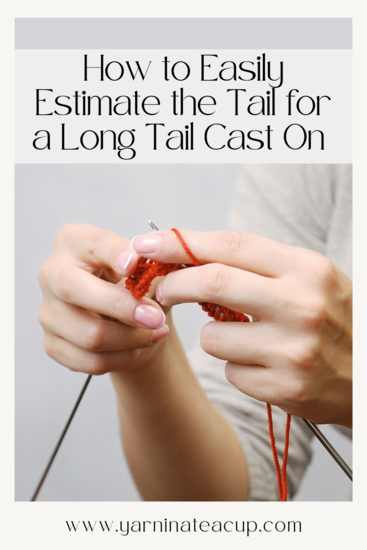
The long tail cast on is a fantastic cast on. It’s quick, easy, and creates a neat edge. You can use it for all kinds of projects, from scarves to cardigans, making it my go-to cast on that I use all the time. If you don’t know how to do the long tail cast on, I have a helpful guide here.
The only downside to the long tail cast on is that it’s hard to figure out how long the tail needs to be. Some projects have you cast on hundreds of stitches, and you’ll need a lot of yarn. If your tail is too short, you’ll have to undo your cast on and start all over. Here are two easy methods for estimating the tail of a long tail cast on.
Cast On Width Multiplied by 4 Method
The first method is very straightforwards: you take the width of your cast on edge and multiply it by 4. First off, we need to know how wide our cast on will be. If you’re making something rectangular like a dishcloth, it’s very easy. Your cast on will be the width of the finished product (as long your gauge matches the pattern’s gauge). If you’re making something more complex, or if you don’t know what the exact width of the finished product will be, you’ll need to do some math.
- Find the gauge for your project.
- Divide the number of stitches by the number of inches in the gauge (usually 4 inches) to find how many stitches there are per inch. Ex: if you have 20 stitches per 4 inches, you would divide 20 by 4, which would equal 5 stitches per 1 inch
- Look at your pattern to find out how many stitches you need to cast on.
- Take the number of cast on stitches and divide by your stitches per inch to see how many inches your cast on is. Ex: 100 cast on stitches divided by 5 stitches per inch would be a cast on width of 20 inches.
Stitch gauge÷4=stitches per inch. Cast on stitches÷stitches per inch=cast on width
Now we know how wide our cast on will be, but our cast on is wrapped around our needles. That means we will need more yarn than just the width of our cast on. Multiply the cast on width by 4. That will give you enough yarn to cast on and weave in the end.
The last step is to properly measure your yarn. It’s important that you don’t stretch the yarn out, as that will throw off your measurements. The best way to measure your yarn is using a table and a ruler or tape measure. Lay the yarn out flat next to your ruler and measure the yarn in 10 inch segments until you reach the length you need. If you need to, you can tape your ruler to your table to keep it in place.
Examples
Say we decide to make this washcloth pattern. It has a rectangular shape, and we’re using the same yarn weight and needle size as the pattern, so we know the width of the cast on is the same as the width of the finished product. According to the pattern, the washcloth will be 10 inches wide, so we multiply 10 by 4, which equals 40. The length of the tail should be 40 inches.
Next, let’s use this fingerless gloves pattern. First, we find the gauge: 20 stitches = 4 inches. Then, we divide 20 by 4 to find the number of stitches per inch: 20÷4=5 stitches per 1 inch. The pattern tells us to cast on 24 stitches for the smallest size, so we take 24 and divide it by our stitches per inch: 24÷5=4.8 inches. Now that we know our cast on width, we just need to multiply it by 4: 4.8*4=19.2 inches. The length of the tail should be 19.2 inches.
Yarn Wrapping Method
This method can be more time-consuming and not as accurate, but it doesn’t require any math. It works best for smaller projects, when you’re casting on 40 stitches or less. Simply wrap the yarn around your needle as many times as you need stitches. Be careful to not wrap the yarn too tightly, or you could end up with a tail that’s too short. Again, it’s not quite as accurate as the first method, and I would recommend adding 6 more inches of yarn to your total to be safe.
Using these methods, you’ll have no problems estimating a good length tail for a long tail cast on. Follow Yarn in a Teacup on Facebook to keep up to date with new articles. If you have any questions about this article, or have a topic you’d like me to write about in the future, leave a comment below!
